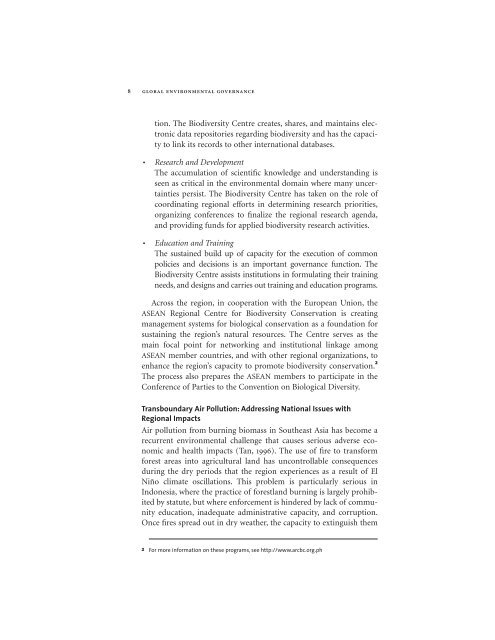Regional Environmental Governance: Examining ... - Yale University
Regional Environmental Governance: Examining ... - Yale University
Regional Environmental Governance: Examining ... - Yale University
You also want an ePaper? Increase the reach of your titles
YUMPU automatically turns print PDFs into web optimized ePapers that Google loves.
8<br />
GLOBAL ENVIRONMENTAL GOVERNANCE<br />
tion. The Biodiversity Centre creates, shares, and maintains electronic<br />
data repositories regarding biodiversity and has the capacity<br />
to link its records to other international databases.<br />
• Research and Development<br />
The accumulation of scientific knowledge and understanding is<br />
seen as critical in the environmental domain where many uncertainties<br />
persist. The Biodiversity Centre has taken on the role of<br />
coordinating regional efforts in determining research priorities,<br />
organizing conferences to finalize the regional research agenda,<br />
and providing funds for applied biodiversity research activities.<br />
•<br />
Education and Training<br />
The sustained build up of capacity for the execution of common<br />
policies and decisions is an important governance function. The<br />
Biodiversity Centre assists institutions in formulating their training<br />
needs, and designs and carries out training and education programs.<br />
Across the region, in cooperation with the European Union, the<br />
ASEAN <strong>Regional</strong> Centre for Biodiversity Conservation is creating<br />
management systems for biological conservation as a foundation for<br />
sustaining the region’s natural resources. The Centre serves as the<br />
main focal point for networking and institutional linkage among<br />
ASEAN member countries, and with other regional organizations, to<br />
enhance the region’s capacity to promote biodiversity conservation. 2<br />
The process also prepares the ASEAN members to participate in the<br />
Conference of Parties to the Convention on Biological Diversity.<br />
Transboundary Air Pollution: Addressing National Issues with<br />
<strong>Regional</strong> Impacts<br />
Air pollution from burning biomass in Southeast Asia has become a<br />
recurrent environmental challenge that causes serious adverse economic<br />
and health impacts (Tan, 1996). The use of fire to transform<br />
forest areas into agricultural land has uncontrollable consequences<br />
during the dry periods that the region experiences as a result of El<br />
Niño climate oscillations. This problem is particularly serious in<br />
Indonesia, where the practice of forestland burning is largely prohibited<br />
by statute, but where enforcement is hindered by lack of community<br />
education, inadequate administrative capacity, and corruption.<br />
Once fires spread out in dry weather, the capacity to extinguish them<br />
2 For more information on these programs, see http://www.arcbc.org.ph
















